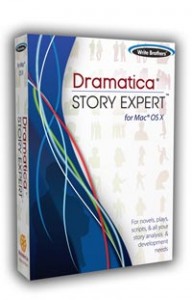POINTS OF VIEW
To examine the Story Mind, we need to know how to look at it. If audiences only looked AT stories, then there would only be one point of view from which to see the Story Mind. But the audience not only looks AT stories, but also becomes involved IN them. It follows that there must be more than one way to look at the structure of a story.
In fact, there are four principal points of view that are necessary to fully satisfy the mind of the audience, and each of these is represented in the Story Mind as well. We'll begin with the most obvious and then explore some points of view that many authors fail to include in their structure, leaving serious holes in their stories.
The first point of view is the easiest: the OBJECTIVE view. We've already encountered the Objective View when we described how we might look at a story as if we were a general on hill, watching a battle in the valley below.
From that perspective, we can't identify the characters by name as we are too far removed from the conflict. Instead, we see them by function - the fellow leading the charge or the strategist, to refer to the examples used earlier.
If we could stand outside ourselves and look at our thought processes objectively, we could take that dispassionate perspective and observe the various logistic and emotional forces at work within our minds. Of course, we cannot do this with ourselves. The closest we come is when we pass judgment on others, observing them outside of their own passionate experiences.
We often say things such as, "If I were you, I'd...." More often than not, such comments get an angry reaction because in taking the Objective view, we have completely ignored the personal experiences that we can't see from the outside looking in. That is why our Objective view is dispassionate. It is not that we don't care about the individual, just as a general cares about his troops. But no matter how intently we seek to understand another from the outside, we can never really know what they are experiencing - what they are truly going through.
When it comes to our own minds, it is the Objective view we can never truly see, for we can never truly stand aside from ourselves dispassionately. That, in fact, is one of the principal reasons audiences are attracted to stories (beyond the simple entertainment value). Stories, through their Story Mind structure, provide a projection of our own minds, in a book, on stage, or on the screen, where we can look into our own thought processes from the outside in, made tangible as characters, theme, plot, and genre.
The author is essentially saying, "I have some life experience or some special insight that I can share about the big picture, the larger meaning of life in which we struggle." It is the author's argument that when this Objective view is taken into account, we can learn when we should go against what feels right personally, or when we should ignore the admonitions of others and go with our gut instincts.
So it is from this Objective view of the overall story that we see characters by their functions, such as Protagonist, Antagonist, Reason and Emotion. And each of these archetypal characters represents a broad quality of every human mind. We'll explore each of those characters of the mind soon. But first, what about that passionate internal view?
Returning to the general on the hill, suppose we zoomed down and stood in the shoes of one of the soldiers on the field. Naturally we lose our overview of the grand strategies and movements of the battle as a whole. But we are now intimately involved in the battle itself.
WHAT'S ON YOUR MIND?
You have an idea for a story. In fact, you have lots of little bits and pieces of ideas. But how do you put them together into something that makes sense? Your enthusiasm can carry you so far, but at some point you're going to wonder how to fit everything in and how to figure out what happens next.
Here's how the Story Mind can help. First, ask yourself what your story is about. Don't describe the order of events at this point, just describe the set-up. For example, "My story is about people trapped in a space ship with a monster," or "My story is about a man who lacks compassion."
Like our minds, the Story Mind examines issues in it's environment and issues within itself. So, if your story is about something something like people trapped in a space ship, that's an external issue within the outside universe. But if your story is about a man who lacks compassion, that's an internal issue within a person's mind.
So ask yourself, "Is my story about something external (Universe) or something internal (Mind)?" Of course, every external situation will create and also be affected by people's attitudes. And, every internal attitude will be affected by and lead to various situations. So, every story will have both situations and attitudes which affect each other.
But how do YOU think about your story? Which is more important to you, the external situation or the internal attitudes? Answering this question is the first step in giving your Story Mind a personality. Is your story more concerned with a situation or with an attitude?
Stories that are more concerned with external situations include "The Posiedon Adventure," "The Matrix," and "The Edge."
Stories that are more concerned with internal attitudes include, "A Christmas Carol," "Who's Afraid of Virginia Woolf?," and "Analyze This."
Saturday, May 2, 2009
Subscribe to:
Post Comments (Atom)







No comments:
Post a Comment